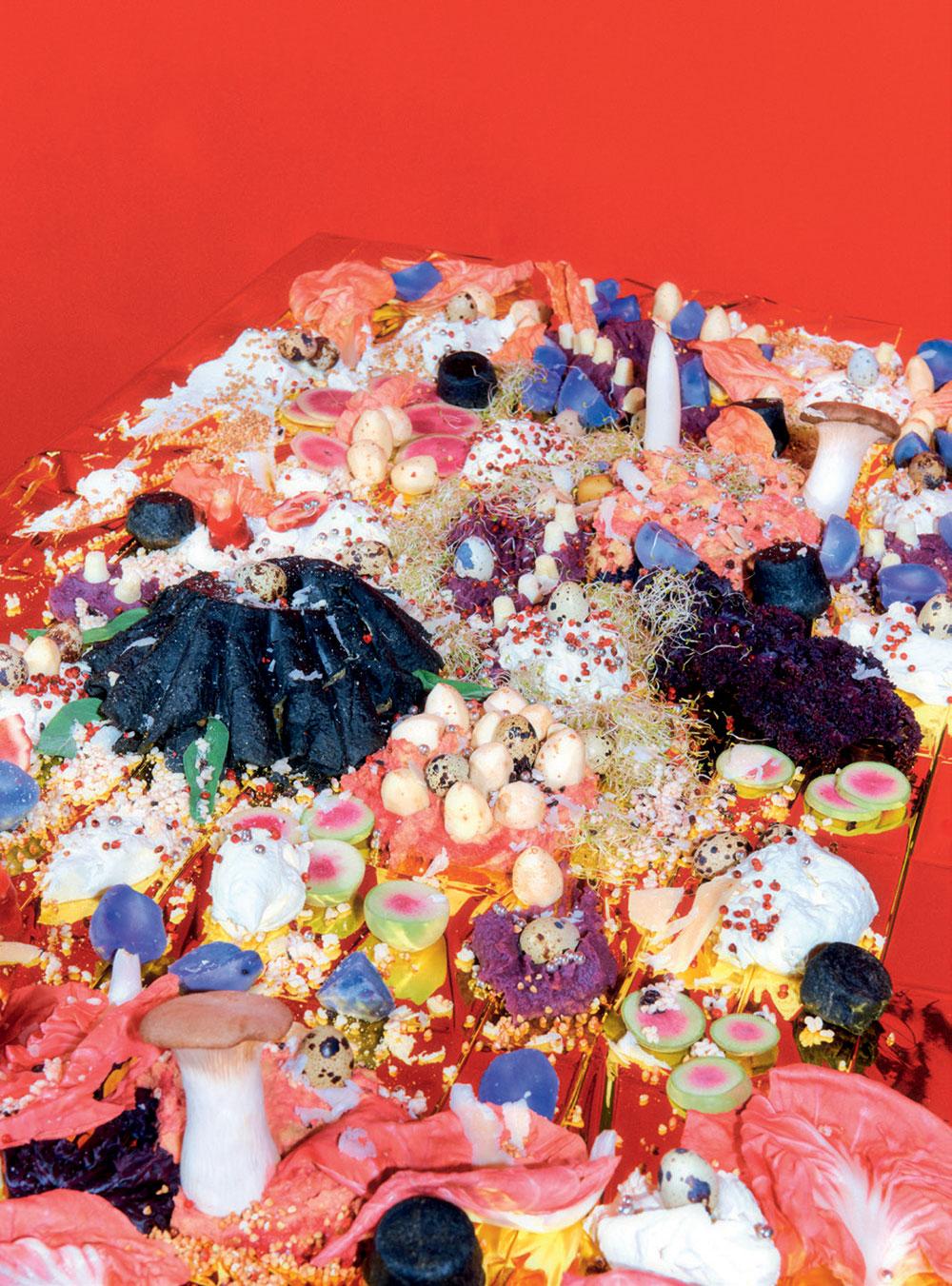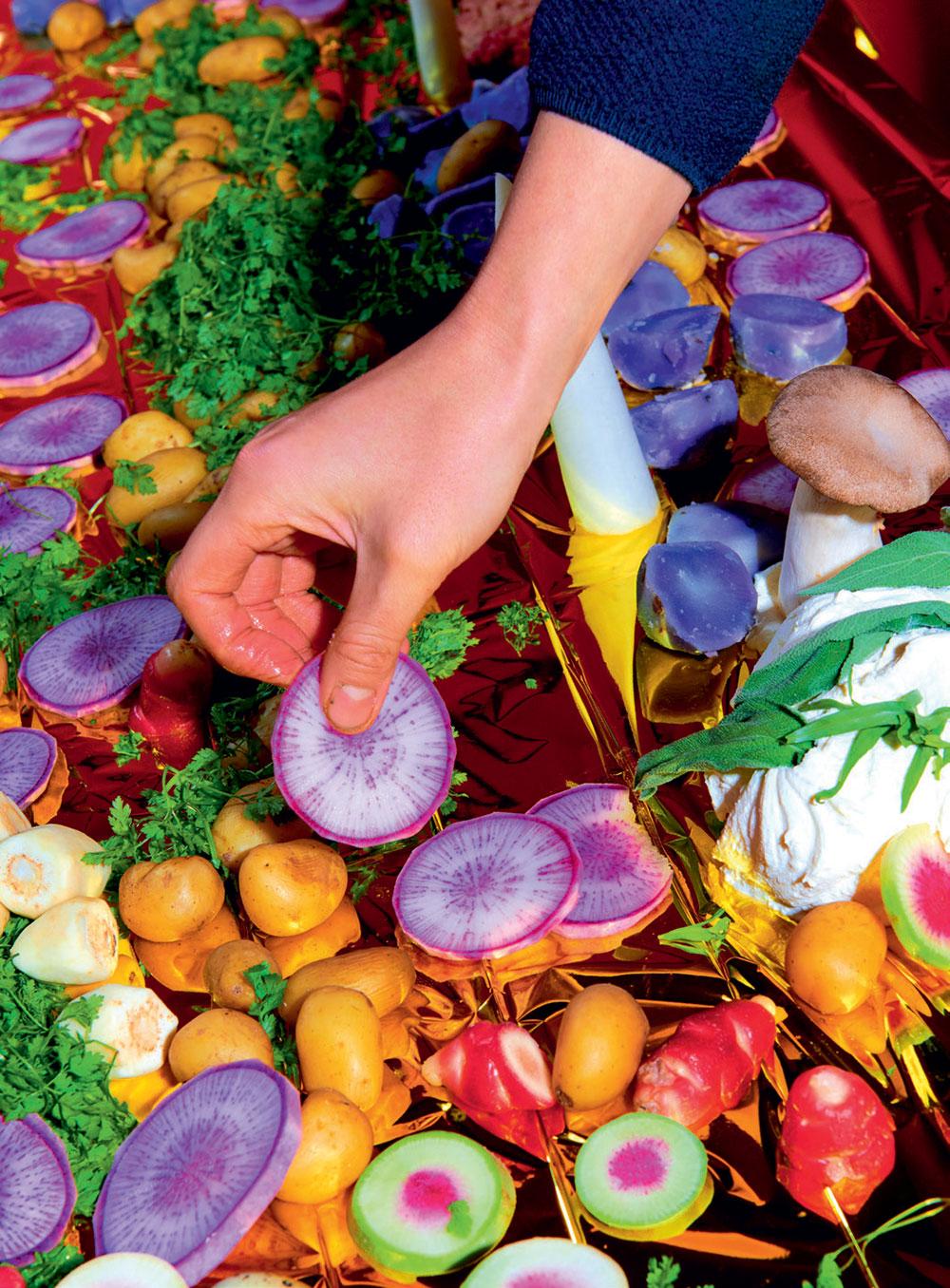Super food: Lei Saito's existential cuisine

Metaphysics and food go hand-in-hand in the world of Lei Saito. The Paris-based Japanese artist began her career in the studio of Annette Messager, the doyenne of French feminist art, experimenting with different mediums until she found her voice with culinary installations. She has created ‘decapitated’ pastries dressed with raspberry coulis for a Bastille Day party at the Palais de Tokyo; designed an edible landscape of violet and yellow vegetables for a dinner at London’s Matchesfashion; and installed a skating rink filled with clementine juice in Paris’ Galerie de Multiples.
‘Experiencing l’heure bleue – that special twilight moment of the day – is integral to understanding that piece,’ she muses. ‘Being complementary colours, orange and blue cancel out each other and everything becomes transparent.’

The colourful installation at Centre Pompidou included vegetables, choux buns, creamy goats’ cheese and rabbit pies.
She calls her culinary practice Existential Cuisine. ‘I use food to tell beautiful, tasty and conceptual stories,’ she says. ‘Each menu germinates from a key word, which I develop into a tale I read as a child, or a world in my imagination.’ Listening to Saito, you are quickly caught up in her fantastic game of word association. The artist seems to have invented a language of her own, drawing on English, French and Japanese idioms, fitting like a butterfly between subjects ranging from mythology to etymology, with a little Alice in Wonderland thrown in. All these references are baked together, as though a marble cake.
‘I’m not a cook, so my recipes are quite simple. But I carefully select my ingredients: organic as much as possible, right off the farm, seasonal and colourful.’ Saito does everything by herself, from grocery shopping and cooking to assembling the installation, and revels in the transience of her work. ‘In the end, my edible landscape is observed, destroyed, tasted and then vanishes.’

Detail view of Festina Lente, by Lei Saito.
Documented here for Wallpaper* is the latest instalment of Existential Cuisine, Festina lente (Make haste slowly), prepared for a private dinner at the Centre Pompidou. The theme was ‘acceleration’, though Saito is more into slow food. ‘To accelerate, you have to run, or in French, courir. I thought about this phrase, courir sur le haricot, which the French use to show irritation,’ she says. The idea of speed also reminded her of the fable of The Tortoise and the Hare. Transforming the word tortoise into tourte (French for pie), Saito made pies stuffed with rabbit meat. Around these centrepieces, the landscape was completed with a messy spread, including choux buns, coloured hummus, a creamy goats’ cheese named Fromage vite (Speedy cheese) and broken rice cakes titled Urgence du popcorn (Popcorn’s emergency). ‘This is my eulogy for slowness,’ Saito pronounces as she puts on the installation’s finishing touches.
Once the landscape is complete, the piles of bags and jars used by Saito are cleared away and the space is left spotless. As if Alice, who had fallen through a rabbit hole into some fantasy realm, has returned to real life.
As originally featured in the March 2019 issue of Wallpaper* (W*240)
INFORMATION
For more information, visit the Lei Saito website
Receive our daily digest of inspiration, escapism and design stories from around the world direct to your inbox.
Minako Norimatsu is a Japanese journalist and consultant based in Paris. Extremely curious about everything creative, her field ranges from fashion to art, dance, hospitality and travel. She has interviewed many Japanese fashion designers and artists for Wallpaper*, as well as non-Japanese creatives whose inspirations are drawn from Japan.
-
 Debuts, dandies, Demi Moore: 25 fashion moments that defined 2025 in style
Debuts, dandies, Demi Moore: 25 fashion moments that defined 2025 in style2025 was a watershed year in fashion. As selected by the Wallpaper* style team, here are the 25 moments that defined the zeitgeist
-
 The RIBA Asia Pacific Awards reward impactful, mindful architecture – here are the winners
The RIBA Asia Pacific Awards reward impactful, mindful architecture – here are the winnersThe 2025 RIBA Asia Pacific Awards mark the accolade’s first year – and span from sustainable mixed-use towers to masterplanning and housing
-
 Holland & Holland's Range Rover is outstanding in its field: shoot the breeze in style
Holland & Holland's Range Rover is outstanding in its field: shoot the breeze in styleCan you spare half a million pounds for a glorified four-wheeled gun cabinet? If so, the Range Rover Holland & Holland Edition by Overfinch might be the perfect fit